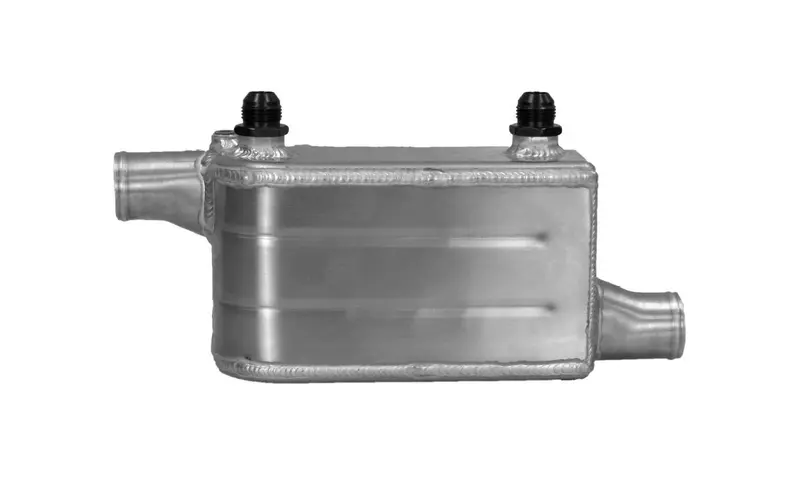Introduction
Water to Oil Coolers is a specialized heat exchanger that transfers heat from hot oil (like hydraulic, engine, or lubricating oil) to a cooler water source. It plays a critical role in maintaining oil temperature within safe operating limits, ensuring optimal performance and longevity of industrial and mechanical systems.
These coolers are especially vital in applications where high temperatures are generated during operation and where oil acts as a primary medium for lubrication, transmission, or hydraulic function. Without proper cooling, oil can degrade, lose viscosity, and lead to equipment damage or failure.
How It Works – The Working Principle
The system involves two fluid circuits:
- Hot Oil Circuit: Oil from the system (e.g., engine, gearbox, or hydraulic line) flows through a series of tubes or plates inside the cooler.
- Cooling Water Circuit: Cold water from an external supply or cooling loop passes through an adjacent set of passages, absorbing heat from the oil.
Heat is transferred through a conductive barrier (typically made of copper, stainless steel, or other alloys), with no direct contact between oil and water. The design ensures efficient thermal exchange while maintaining separation of fluids.
This design allows the oil to be rapidly cooled, ensuring that its properties are preserved, and the system remains stable during long operating cycles.
Key Features and Benefits
High Cooling Efficiency
Water has a much higher thermal conductivity and specific heat capacity than air, enabling rapid and consistent heat removal from oil. This results in faster temperature regulation and enhanced system reliability.
Compact Design
Thanks to water’s superior cooling properties, the heat exchanger can be designed smaller than air-cooled units for the same performance level. Ideal for systems with space constraints or where portability is essential.
Quiet Operation
Since the cooling process doesn’t involve noisy fans or blowers (as in air-cooled systems), it operates almost silently, making it perfect for noise-sensitive environments like laboratories or marine vessels.
Prolonged Oil and Equipment Life
By maintaining optimal oil temperatures, it reduces thermal stress on oil and components, minimizing oxidation, foaming, and sludge formation, which in turn extends the lifespan of pumps, engines, and valves.
Serviceability
Many designs feature removable tube bundles or access covers, allowing easy inspection, cleaning, or part replacement, minimizing maintenance time and cost.
Common Applications
Water to oil coolers are used in a wide array of industries and equipment types, including:
- Hydraulic Systems in presses, excavators, and forklifts
- Marine Engines and propulsion systems where seawater is used as a cooling source
- Gearboxes and Power Transmission Units
- Injection Molding Machines in the plastic industry
- Industrial Compressors and Blowers
- Diesel Generators and Backup Power Systems
- CNC Machinery and Precision Tools
- Chemical Processing Plants using lubricated or hydraulic drives
Unique & Advanced Benefits
Water Source Flexibility
Can operate with various water supplies — freshwater, process water, or saltwater (when made with corrosion-resistant materials). This makes it adaptable across different geographical and industrial environments.
Energy Savings
Requires no electrical input for air movement like fans. When integrated into closed-loop cooling systems, these coolers reduce operational energy consumption significantly, offering long-term cost savings.
Superior Thermal Accuracy
In high-precision systems (e.g., aerospace or medical), even a 1–2°C temperature fluctuation can affect accuracy. Water to oil coolers allow for precise thermal control, stabilizing equipment for optimal function.
Corrosion-Resistant Construction
Made from SS 316, Titanium, Cupronickel, or Aluminium Brass for high-performance in aggressive environments like marine applications or chemical industries. Materials are selected based on water quality and fluid compatibility.
Custom Flow Design
Many coolers allow flow path customization — such as adding turbulence-enhancing baffles — to optimize performance for different oil viscosities or flow rates.
Foam and Oxidation Reduction
By cooling oil promptly, the cooler limits the formation of bubbles (foaming) and oxidation, both of which degrade oil performance and can damage equipment seals and components.
Conclusion
Water to Oil Coolers serve as a backbone of thermal management, offering unmatched efficiency, reliability, and adaptability. Their ability to maintain consistent oil temperature not only enhances equipment performance but also protects critical components from thermal degradation.
By choosing the right material, design, and capacity, industries can achieve:
- Higher energy efficiency
- Longer oil service life
- Reduced downtime and maintenance
- Lower operational costs
With options for custom design, corrosion-resistant materials, and dual cooling capabilities, water to oil coolers are a strategic investment for any operation where thermal stability and equipment protection are essential.

